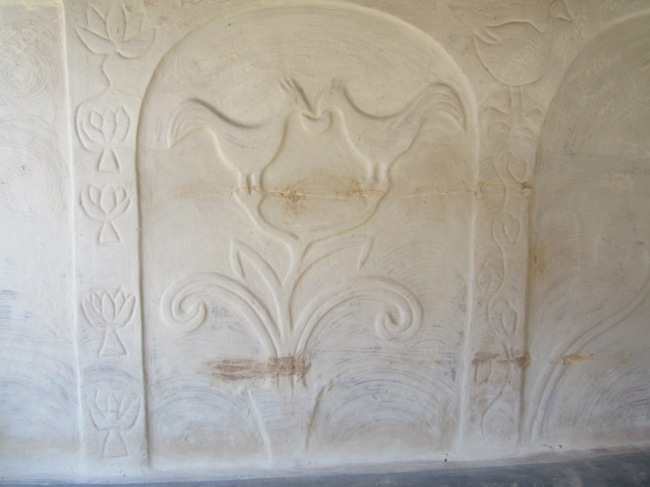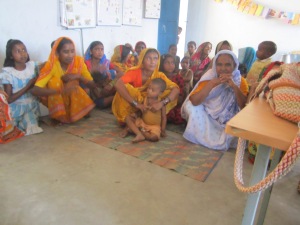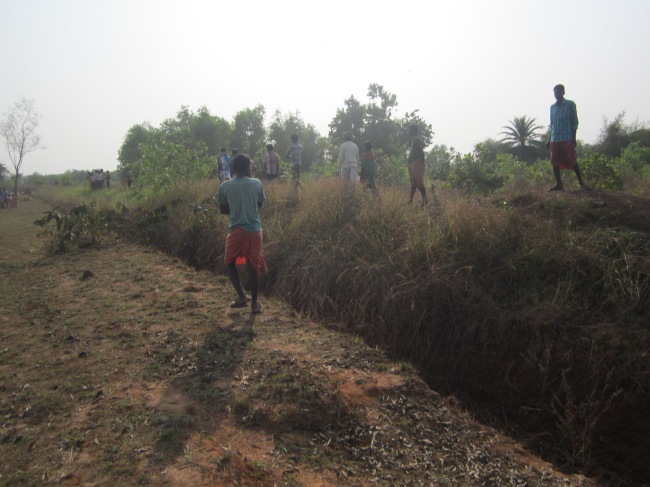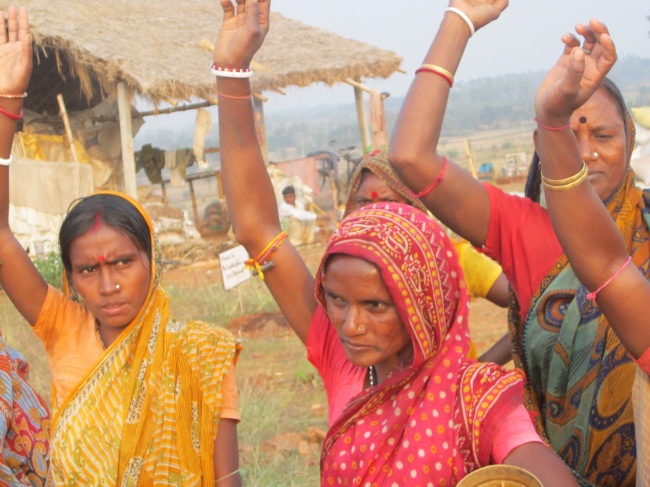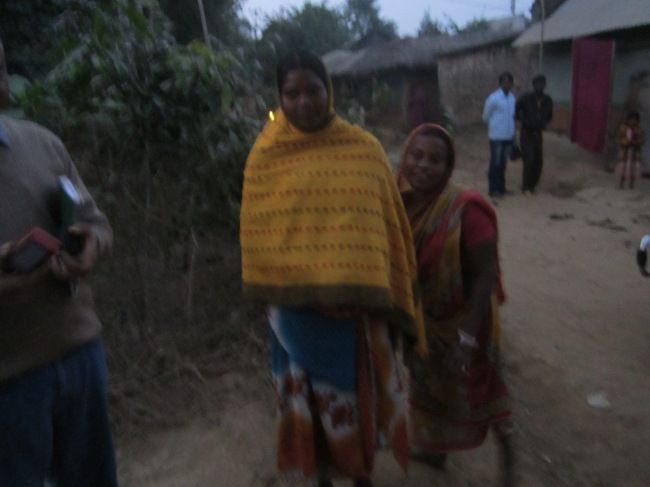Pulse perspectives in Bankura District,W.B.– Workshop summary
September 7, 2017
Enhancing Food and Nutritional Security and Improved Livelihood through Intensification of Rice Fallow System with Pulse Crop in South Asia– a time-bound farmers’ friendly project funded by international repute organizations; ICARDA & IFAD, has been in operation in the state of West Bengal under the umbrella of Bidhan Chandra Krishi Viswavidyalaya. The main objectives of this project aims at increasing area, production and productivity of pulses and incorporating pulse based farming systems with technological intervention in backward and stressed areas of the state. Last year this project covered Paschimanchal, Sundarbans and parts of alluvium regions covering more than thousand stakeholders. Major emphasis was given to the dry-tracts of the state including a good number of blocks of Paschimanchal falling under Paschimanchal.
Considering tremendous response from the farming community Prof. Rajib Nath- the Project Co-ordinator has targeted Bankura district with larger areas annexing more blocks in the coming rabi-season. Accordingly, one day interactive session cum workshop was held in Bankura headquarters on 4th September 2017.
A team of Scientists and Scholars of BCKV led by Prof.Rajib Nath started journey towards Bankura on 3rd Sep. from Kalyani in the morning. The team halted at different spots of the district while on move, observed topography, standing paddy crops, and other criteria for pulse possibilities in the stressed areas. On the spot interactions with locals were also held at G.Ghati and Chhatna blocks. A new area dominated by tribal in Chhatna block was studied. Tribal leaders of the village Gurputa were interacted . Across discussion members of the Farmers club were invited to join in the scheduled workshop at Bankura.
The venue of the scientist-farmer interactive workshop was at Krishi Bhawvan. Joint Director of Bankura range arranged logistic facilities for the event. Moreover, he requested agricultural officials of different blocks of the district to share during workshop.
More than eighty farmers representing Chhatna, Bankura-2, G,Ghati, Raipur, Ranibandh and Simlapal assembled in the program. Many of them were mouthpieces of Farmer’s clubs, Co-operatives, Local NGOs and farmers-friendly bodies.
In the beginning Prof. Rajib Nath introduced the house with the objectives and mission of the pulse-project. A brief on the plan of action was presented to the stakeholders.
Dr.D.D. Patra, Vice Chancellor of BCKV inaugurated the workshop and Prof. A.Mitra, former Director of Research presidedover the function. Incidentally, both Dr.Patra and Prof.Mitra are son of the soils of Bankura.
Vice Chancellor in his majestic speech pointed to the opportunities of growing pulses in the present scenario of farming. According to him pulses could be incorporated as a relay pattern or as mixed crop with winter vegetables or other crops. Further, he highlighted cost-effectiveness of pulse growing and its power of soil improvement properties in terms of adding nitrogen in the soil. In his address he cautioned them for using indiscriminate and excessive fertilizers in the soils. The merits of using bio-fertlizers, balanced nutrients and suitable cropping pattern were addressed by him. He emphasized for inclusion of at least one pulse to mitigate soil degradation.
Rammoy Patra, Former Dy.Director of Bankura, Agril.Department requested the participant-farmers to grow pulses instead of potato as the latter’s market is volatile and potato involves much expenditures. He also discussed on the nutritive deficiency of rural people and advocated pulses to mitigate it. According to Patra farmers could fetch more prices if milling is done.
Bidyut Das presented a synoptic agricultural status of the district.He lamented for the sordid position of pulses in the state . According to him pulses are grown in the marginal lands without care. In his deliberation he mentioned the various socio-economic constraints of pulse growing and urged for collaborative drive in a convergent mode.
Sadananda Maharaj graced the occasion and welcomed BCKV-project officials for its mission in the district as well as in G.Ghati.
Sri Pachanan Layek a progressive farmer of the Chhatna block cited his experience of pulse-growing in his cluster. According to him BCKV intervention ,particularly the replacement cultivars of Khesari and Chick-pea yielded more than expectation as well as average yield of the area. However, musur yield was not as high as the other types. Low yield performance of musur in Bankura district was discussed. Prof. Somenath Bhattacharyya pointed out the reason of late sowing as one of the major causes.. In Bankura farmers normally harvest their paddy in late comparing to Gangetic regions. He advocated for growing short term paddy cultivars so that lentil could be sown by October .
Prof. Rajib Nath in his deliberation discussed on the importance of pulse-growing to mitigate hungerm malnutrition and poverty. From last year’s records he mentioned the hopeful perspective of pulses in Bankura district. He shared his in situ experience of cluster visit . According to him some minor changes in the technique of the production could give better results in terms of yield. He stressed for appropriate variety, rhizome uses and management practices for higher yield.
Dr. Binoy Saren, Visva Bharati discussed in length on the scientific cultivation process of pulses. In his long speech he pointed to the issues of (a) varietal choice, (b) seed treatment and seed priming, (c)plant protection, (d)weeding and harbicide use, (e) life saving irrigation and (e) pest management.
Dr.Tapas Biswas discussed on the importance of using organic manures and bio-fertilizers. The technique of using rhizobium was shown to the participants with visual aids.. Merits of organic pulse growing was discussed in course of deliberation.
Next, Dr. Raju Das interacted and shared with the house in pest-management practices. Farmers’ queries were answered by him. Dr. Das asked them not to rely on retailers or dealers for pest control . According to him they need to identify the diseases, pests with the support of technical persons or experts to overcome unnecessary costs.
Prof. Somnath Bhattacharyya nicely conducted the interactive session and recorded the points of intervention in the coming days.
Prof, Mitra summarized the proceedings and Prof. Bhattacharyya gave vote of thanks.
2014 in review
December 30, 2014
The WordPress.com stats helper monkeys prepared a 2014 annual report for this blog.
Here’s an excerpt:
A San Francisco cable car holds 60 people. This blog was viewed about 430 times in 2014. If it were a cable car, it would take about 7 trips to carry that many people.
A revisit to Ajodhya Hill
June 24, 2014
After a pause of about three years my dream -day came on 19th June this year. I am excited… I feel much hope today as I have to go Ajodhya this time. In my last visit I got a mixed experience – a sense of admixture of fear and joy at Ajodhya Hill. That time it was turbulent, people were always panicky, they seldom used to come forward and spark frankly and freely. I had to reach there escorted by military all along the road. Guard persons were also suspicious on our movement. Doubtful minds of ours, peoples and passersby made a cloudy atmosphere in hill regions. I must give thanks to Grameen Bikash Trust to initiate developmental works in the most awkward part of West Bengal. That time it was the mission of strengthening and developing WADI projects in hill areas of Purulia. WADI project aims here in establishing Orchards. They started setting as many as 150 mango orchards in a collective manner. GVT set up own establishment there despite all odds and difficulties.They recruited energetic staffs who are mobilizing tribals. Those brands are giving confidence to the resource poor and making new avenues of farm 7off-farm activities. They have already set up SHG –groups monitored and maintained by local people. GVT is doing wonderful works for them. I heard all those. I read many documentary published by them. I also got information from other sources about their dedicated services.
I started my journey from Kalyani accompanied by my friend Subrata Sarkar. I feel comfort with his presence. It is always a learning session with him. I met a few who have grasped the rural fabric by heart. His doggedness to goal inspires me a lot. He is a real challenger.Despite ill health and doctor’s advice for rest he is adamant in his own mission. I recall those days of journey with him in Sundarbans, or Bagnan where he led and moved masses at one stroke.
I was listening to his experience of Ajodhya hills. It was raining as we reached Purulia around10.30 p.m. He had arranged everything. I took shelter in Akash hotel. I could not sleep with excitement. I woke up at 4.00 a.m. I came to the Balcony from where I was looking to the Court where I used to come frequently. My uncle was a government servant there. Once, Prof.Dilip Dasgupta –the then ViceChancellor along with Dr.P.R.Dasgupta, the the Technical In-charge came here and met met my uncle to discuss many issues. I was also looking at the Victoria School where my relation served as Headmaster for many years. Many stories cropped up when I see the court areas.However, it was raining all through night. I had a desire to visit Ajoydhaya during rains. God is generous this time. He sent rains.
Journey amid rain is always joyful. For the last two weeks we were experiencing hot waves,scorching heat and warm –moist weather. We wanted to get rid of it. Farmer have been fervently waiting for God-rain. In hilly areas there are many creeks. These dried tracts were flowing ina full rhythm. Fields were filled… birds were bathing dipping their heads;Sorrows were ready to catch prey. Mud fill roads checked the speed of the car. Gentle movement gave us moments of seeing nature. We reached the top hill. A venue for gathering was fixed in an abandoned house. During terror period the building was left. However, I was hesitant whether farmers could come. Bimal Da who is having a saint-like live here was confident about stakeholders. Sooner I saw them reaching braving the rains. Tribal youths have been trained and disciplined in action by Bimal Da. Bimal da is a strong personality. He left his comforts in Kalyani and started-austere living here amid nature and tribal.
It was around11.30 tribal from Majhidi,Puniasasan,Kuchariraha and other hamlets reached in the venue. They were all WADI members. GVT targeted 800tribal families under this project since 2012. They have already covered morethan 460 families. I was elated when farmers were showing their keen interest on it. They have already established mango,jackfruit, and ber in their orchards. They are maintaining itunder the technical advice of GVT staff. There are about 60 small villages in the top hill and its surroundings. The entire area is almost rainfed barring some pockets. Maize and rice is the principal crops here. A few of them grow vegetables. Chuniram Mandigrows brinjal,tomato,raddish. He was telling his misery of growing as there isno market. Jairam Besara also planted tomato. Besara grew potao in his .50bigha of land. He got 10 bags of harvest. Avoy Besara harvested mustard for home consumption. All were discussing about their crop-pattern. Low value crops with low productivity is the main point of discussion . Another part was their non-awareness of cost-returns of crop. They never see farming as commercial venture. They are also keeping goats, chicken-birds but to a small scale. One or a few have milch cows. There is also demand for milk. They grow vegetables at their homestead but for own uses.
With constant effort ,support and monitoring GVT has changed their mind set in growing fruittrees in the up and barren lands. I was invited to show them success story of growing turmeric in between mango trees. I told them why Hill top is ideal for this crop. Why mango orchards need intercropping with turmeric. They were listening and interchanging ideas, They all agreed to plant turmeric.
Subrata Sarkar,the head of GVT interacted with them. How to market this produce was a common question here. We encouraged them to process turmeric in a collective way. If production reaches to a large extent SHG-members can sell it at local markets.Government is running a good number of mid-day schools in the region. They would be potential buyers,
All is hope. I hope a convergent efforts by many institutions operating in Ajodhya Hill will usher in a new look for the tribal of Ajodhya. This area is now peaceful. Further peace depends on our future steps.
Unheard Creativity of Tribal Women
May 20, 2014
Voices of Santhal tribal in Chotanagpur are heard whenever there is a witch hunting or inter caste marriage or rape or land grabbed by greedy urban politest. Their voice again becomes rhetoric whenever leaders lead them taking advantage of their poverty and misery. Their words are to a lesser degree voiced and protested whenever they are ousted from own territory for urbanization or development. This practice of voicing tribal cases is an age-long tradition.
Of late, their songs, flutes, music, gay dance and dialects have also become our special tastes in occasions. However, this context is different and unheard. Voices of tribal women transpiring on walls.
Recently I visited some tribal villages in Purulia- an off-shoot of Chotonagpur plateau. Purulia is a hub of tribals of diverse groups and culture. I shall restrict to the voices of Nildi Majhi gram. A beautiful village is situated beneath a small hillock-Nildi. Nature and people live in together. There is always conflict and harmony between them. Amidst their natural life-style I was struck to the majestic walls of their houses. All houses are made of natural materials. These are mud-houses. Cleaned and attractively walls decorated with designs and arts. All those are creative objects of Santhal Women. I was spellbound how they make such wall murals with home-made ingredients. These wall paintings reflect the inner voices of simple women. They highlight the co-existence of nature with community. They portray the birds, flowers, animals and other living organisms surrounding their habitat. Those Santhal women are born artists. They have no formal art-training. They do not know the chemicals being used in wall murals. They only know to voice their feeling. They are peace loving guys. Eyes become cool to see their paints made from mud. Sometimes I feel those Santhal women are regarded un-skilled in every sphere. No body dares to share their skill-knowledge in city or towns giving them the task of creating murals. Their story remains unheard. Their culture, knowledge and values not being used in creating knowledge-based society.
LUTFUNNESSA-THE SYMBOL OF DIGNITY
May 12, 2014
Nutandi is a tiny village in West Bengal, India. The village is dominated by Muslim population. There are about 650 Muslim women voters in this village. The darkest spot of Nutandi has been of denial right -ship to women .They are prohibited by males from casting vote.Surprisingly, Women of the village could not exercise votes in Elections since independence. The fact was no longer hidden,it came to the media during 2011. Again,it was surfaced recently.
It is difficult to get the reasons behind such cult. Women of this village do not wear full length Purdah(veils). It is not that women are prisoners confined to home only. I saw many of them going to markets,banks ,health centers and other places. There are a good number of educated people living here. There are also a good number of girls enrolled in primary school. The village is well connected with nearby towns. Despite , age-long tradition is going on there. Women would not participate in the Election process. Most interestingly, Last year a woman of this village was contestant to a local government,surprisingly the very lady did not cast her own vote. In fact, women have been living here in a low profile with inherited inferior status. The tradition of the village is ‘hidden wife is a good wife’. Males are not ready to give power to the women.
In above situation, Lutfunnessa-a young lady revolted. She gave a call for change. she stood amidst adversity and criticisms. She is the first women in Nutandi who cast vote since independence(1947).. Following her pursuits,thirty women came forward and slapped the orthodox rules of the community.
Lutfunnessa has been awarded by the Election Commissioner.
Battle for Women Empowerment: Nutandi
May 6, 2014
Ajan for freedom from Gohara Bibi stirred the whole Nutandi village. I experienced a new reflection day before yesterday at Nutandi. I saw and witnessed a dazzling look further than I could imagine. Jahanara Bibi danced with brave gestures, throwing hands, and showing fists in front of us. She did not hesitate to speak her inner voice to the small gatherings. Surprisingly there were outsiders and male-members .I realized what Azadi is to the Muslim women of Nutandi. I perceived Azadi is boundless, spontaneous and vibrating. Now I am far away from Nutandi but the words of Jahanara Bibi still ringing in my ears. I am fortunate to meet Jahana a warrior against autocracy.
Two weeks back I discovered another rebellion against autocracy. She is Lutfunnesa. –a young guy around twenties by appearance. In a group, I saw her agitated. She reiterated loudly & emphatically in front of male counters pointing their slanting attitude, partition outlook to the women. She cautioned the males for their fatwa prohibiting women from casting votes. I was overwhelmed seeing a brave young guy out crying for freedom .On that day in the group she was the single women. I admire her boldness and call for women empowerment. On returning back, I enjoyed telephonic talk with her. She is adamant and vowed to cast vote on 7th May… She wants to give a lesson to the orthodox people. On my query, she referred to a college girl. Who will defy male’s fatwa this time.
Utpal Ghosh – the able executive of Raghunathpur Block-11 took a challenge for Nutandi. Under his constant supervision every eligible women of the village has been provided with EPIC. Sri Ghosh initiated a good number of social projects in the villages. He has become a frequent visitor to the village. A new brand of energetic personnel have been put to the village to educate and empowering women. I heard that he had discussions with the Imam. , school teachers of the village and leaders of all parties for ensuring women participation in the election process.
Finally, he wanted civic bodies to operate in the village. Accordingly, to his call SHGs, Sri Arabinda Society, Manbhum Sanskriti Kendra came forward. Jagati Bagchi- a social activist is now in Nutadi. She is in constant touch with the women braving the sultry heat. Bagchi will not leave till election is over on 7th may.
Media has shown their interest on the issue. Their penning drew many to support Utpal Ghosh to this noble cause.
It is around 2-42 p.m. Paresh Majumdar along with Jagati returned. They are hopeful.
I am waiting to see the battle for empowerment of women in Nutandi tomorrow.
Sabui-Grass: A Livelihood Option
January 24, 2014
Sabui grass or Babui grass is a known crop to the tribal since long. There are many legendary stories on this crop ,you can here these from HOs or Sabars in Chotonagapur Plateau . Bompass ,Boadings’ writings on folk lore of Santhal Parganas witness close relationship between sabui & tribal of eastern India. Similarly you can have reference to the crop from W.W.Hunter’s description on Chotonagpur. However, Sabuigrass came into light during nineteenth century when the then Government made survey on this grass for feeding their paper industry . They also attempted to its feasibility in exporting in their own kingdom,UK. A good materials on Sabui grass is found in the monograph written by D.N.Mukherjee(1908): Paper & Paper Mache in Bengal.
To Lodhas, Savars, & other tribes living on Non-Timber Forest products call this grass as ”money plant”. The grass which was abundantly grown in hills, jungles as wild is now cultivated in the Savariya territory of Mayurbhanj,Baripada of Orissa, Santhal parganas,Singhbhums of Jharkhand, Purulia, West Midnapore & bankura of West Bengal. In Mauerbhanj,the weekly hut of Dantiamuhan shows crowding for Sabai-grass business. Nayagram Block is famous for Sabuigrass . Neogi and Beligarh represent centres for sabui-trade. In those markets, raw sabai grass, sabui made twines,ropes are sold. In other occasion sabui-made artifacts are brought for selling.
Nayagram has the advantage of its territorial position as it is adjacent to Orissa and Jharkhand in terms of marketing. On the other hand, there are vast waste lands unsuitable for crops other than sabui in this block. Recently I visited the block for experiencing MNREGA -convergence schemes. However, this crop attracted me
- Sabui-grass is a traditional crop could grown in barren, infertile, up- wasteland where no-irrigation facilities exist.
- Minimum labor, zero-tillage and almost nil-capital is required to cultivate.
- Could be grown as an inter-crop with the Euclaptus plantation
- This crop will add bio-diversity, check soil erosion
- Sabui-is a fodder in dry region
- It has domestic values for making thaches,roofs,homemade twins,ropes ,brooms tec.
- Women are involved in value addition process
- Differnt kinds of artifacts are possible from Sabui.
- Tremendous prospects in Paper industry as a raw material
- Charpis-made from Sabui grass are in large demand .
- scope for Micro-& small scale industry in employment generation for tribal.
- Hilly & sloppy tracts could be brought under green-coverage in convergence with MNREGA project
Considering its importance in dry regions of Paschimanchal strategic action plans are required.
Makar Sankranti : My memory
January 14, 2014
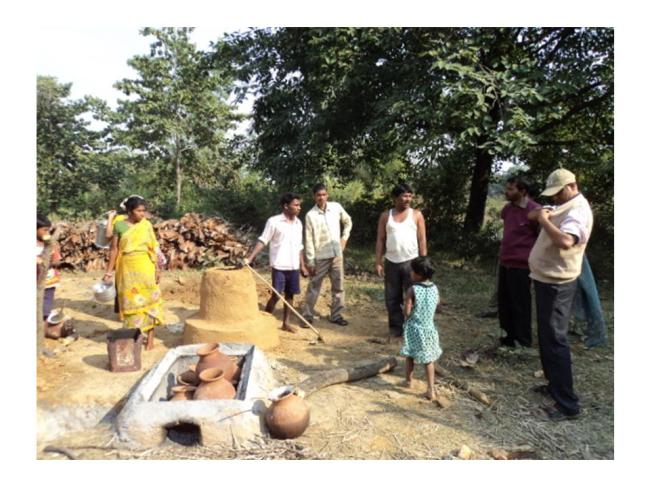 r sankrantiDipping in holy water at the dawn is the ritual practice of common Hindus in Bengal. People from other parts are no longer laggards in this respect. Toady , in this very Makar day , Ganga Sagar has been a leading news in media. Large crowd gives the shape the mammoth mela. Again, Ganga Sagar mela is now not limited to India but an interesting subject to Westerns. Apart from Sagar, we see such congregation on the banks of river Ganges people cleansing their sins, memorizing ancestors and hoping for future.
r sankrantiDipping in holy water at the dawn is the ritual practice of common Hindus in Bengal. People from other parts are no longer laggards in this respect. Toady , in this very Makar day , Ganga Sagar has been a leading news in media. Large crowd gives the shape the mammoth mela. Again, Ganga Sagar mela is now not limited to India but an interesting subject to Westerns. Apart from Sagar, we see such congregation on the banks of river Ganges people cleansing their sins, memorizing ancestors and hoping for future.
I recall my childhood past in Bankura & Purulia. There are no Ganges but Damodar, Kasai ,Subranarekha & other small rivers. All these streams turn to holy spots. in my native place we have no rivers . We have one holy pond. It is named BOLPUKHUR. There are many myths with this pond. The Pond is regarded as a lve-entity. The pond speaks to the holy persons. I recall that all we surrounded to the spot at mid-night ,say around 2-3 p.m. in every para there were groups who will march the place.. capture the best place . The day was the final of month drawn preparation. Straw gathering by snatching, begging or any means were the month -long preparation . Any cart load passing through street was forced to donate straw-club for Makar sankranti. The caochman of the bullock cart loaded with straw in many occasion voluntarily gave straws to the kids. however, all of us thus collected huge mass of straws. On the day of Makarsankranti, we carried those to the Bolpkukhur at mid-night. There were bon-fire. Warming the body we used to dip in the cold water of Bolpukhur. Finishing this with cheerers and louds we return to home. we are cleaned .
Gargara pitha is ready . Khejur-gur is served. all we enjoyed . there wer competition among our brothers in terms of eating Gargari-pitha. we used to count in terms of Pans.
The day is also the finishing day of Tusu. The whole month girls have devoted evenings by singing Tusu. Tusu represents clay balls mixed with cowdung & husk placed in earthen Mangal ghat. Girls dip in holy water. The bolls are immersed and return back with new clothes with singing. A festive look is found all over there.
I happened to go to Arsa and saw how Tusu was being felicitated in the banks of Kasai river. Similarly, village festival in Subrnarekha I memorize. Those days are past. I am far away.. but pitha, tusu are still vivid in my mind.
I took pithas here but these are different from Gargari.
Success Story of MNREGA : Khatra,Bankura,West Bengal
December 24, 2013
My recent visit to Khatra Subdivision is a windfall to my experience. The panoramic views of Mukutmanipur and surroung hills .hillocks and dam has undeniably smoothened my mind. However I got much more than expectation while visiting success of MNREGAs here. On other days whenever I roamed Jungle Mahal I had been skeptic as well as pessimistic about MNREGA. I saw scattered ,unplanned and unproductive works done with the support of this mega project. Community as a whole harvested little from it. Sporadic ventures failed to make it sustainable and productive. Multiple positive buds from MNREGA did not come out. Seldom people felt it their project. This very impression pained me every time. However, after visiting orchard rearing under the umbrella MNREGA in Khatra sub-division changed my mind set. Now I am hopeful with the inherent power of the project on seeing some of those brilliant works.
The sole objective of the project is not to give jobs to the odds in any way but to create social assets simultaneously. It must be productive and bear fruits continuously. Community must share fruits equally. Another point is important to its mission is of social participation, social inclusion and social resource preservation. Equally important is of incorporation of bio-diversity, which is economically, ecologically vibrant.
One of the poor blocks in Khatra sub-division is Indpur. The block is dominated by tribal and scheduled castes. Those low-order people are landless or owner of a bit of lands. Topographically the entire area is undulating, rain-fed and terrain of infertile soils. Paddy is the single crop of the region barring some patched areas. Vast barren lands are there with out greens. The poor groups have to migrate other parts in search of jobs. Poverty and misery made them depressed and cynical. Tribals and other SCs lost their confidence burdened with shocks and stress all the time.
Under above situation Dr.Babulal Mahato- a young block level administrator of Indpur block saw hope within MNEREGA project. With his agricultural background he wanted to experiment his earned technology blending with administration and people’s participation. He wanted to make them involved in mango orchard farming. Initiall it was not an easy job. However, ultimately he managed to bypass negative thoughts. Landowners of the community agreed to his ideas of leasing lands to the SHGs teamed by tribal and SCs. Under Mnrega he flowed funds for best utilization of fallow lands with potential ventures. He has shown Orchards prospects in many parts of the block. I have already written the success story of Lipidiri. He has already set up 130 gardens. The new venture is now at Brahmandiha,gram panchayat, in Bhalukbhasa village in Phhlkhusma mouza.
Under Babulal’s stewardship seven SHG-groups have been formed. One of those group is of Sardars who are tribal. These seven groups have taken lease land of 250 bighas of in a compact block. Groups have been tied with local panchayats. Input costs like fertilizer,compost,saplings and other contigent materials are supplied by the Panchayats. Lease sharing is on the basis of 40:50:10 among SHGs, Landholder and Panchayats . Landholders and Panchayes will receive share after the garden starts harvesting. This project came into operation from 8th August 2013. They have already sown abot 10000.00 plants. Works is on full swing. Groups have cultivated seasonal vegetables. We were offered tasty cucumber while on the field. Priyotosh Pathak a rural youth is monitoring the whole program. Pathak’s sacrifice moved me. I apprecaiate his challenge change in this drought prone area.
Babulal accompanied me the spot. We shared and discussed a lot. We came to conclusion of refinement of the project incorporating diversification of crops and adding non-crop segments.
Unbelievale experience I got in Indpur.
This model is best suited in Junle Mahal. Institutional arrangements of the project can be developed in other parts of India.
MNEREGA is a sharpen weapon , it can weed out all evils if properly used.
SAVAR -TRIBAL DEVELOPMENT : Linkages between SHGs & MNEREGA
December 20, 2013
” Hamar Unnati Hena”- echoed by Malati Savar. The same rhythm came from Santi, Usha Binati & others. They all belong to Savar community in Lipidari village ,Ranibandh,Bankura. They expressed in Kheria tone ” we have developed ours”. I was surmised to their firm,confident and bright looking voice. Savars are primitive tribal . Their origin is referred in Mahabharat,Ramayan. ‘ Savarir’ Pratikhsma(Savarir’s waiting) is an adage in Bengali. In Ramayana, an old Savar-women waited in her hut for more than twelve years for Lord Rama. At last She met Rama. Our old scripts, like Aitareya B brahmana referred to Savars but recognized as a progeny of Dasuys(Decoites). To these literature they were non-aryans. All these pointed that Savars are not civilized sect and forest people and their livelihood depends on hunting, forest-fruit gathering. From the writings of Megasthenes, Pliny,Ptolemy we got some informations on this tribe. The Bharat Samhita ,Markaneya purana & Matsya Purana referred to them wild nomadic race,wandering over hills,living on fruits & forest animals and disobeying rules of the king. Their attacking attitude helped establish Murya kingdom. Limiting those history & origins I say Savars are at distant space from settled civilized world.
Conflict between forest people and rest grew gradually. Finally, Savars lost their authority in hills,forests & jungles. They lost their natural livelihood. Their seperation from the outer world made them under abject of poverty. Death of five Savars under starvation in Amlasole stirred the country a few years back. Savars came into news. Mahesweta Devi- wrote on their miserable status and cried for their betterment. Many NGOs and others also attempted. Another attempt has been made in Lipidiri village in Ranibandh. This story is the focal theme here.
Lipidiri is a small hamlet on the fringe forest area of Ranibandh block adjacent to the Mukutmanipur dam. There are twelve Savar families staying over 3 bighas of land. All the families are landless. They live on wage-renting. most of the time they migrate to other places for livelihood. Illiteracy ,poverty,malnutrition and jobless are common symptoms of the village.
On seeing their precarious situation, Dr.Babulal Mahato- an young guy with administrative and technical know-how determined to do something for those people. An innovative idea sprang to his head. Dr.Mahato wanted to interwroven institutions, SHGs ,& technology . His innovative idea consists of formation of SHGs by the women. Those SHGs took lease of barren uplands from owners on sharing basis terms. Finally, agreements were put to the administration for support. Babulal with his agri-horticultural background trained them to plant mango-saplings under MNEREGA scheme. This idea was accepted by SHG members. Now vast areas of fallow lands are transformed into lush green fields. Their orchards are now in full shape. Returns are high all the Savars are happy.
i happened to meet them. i saw their garden. This role model can be applied else where in Paschimanchal. I also came to know that similar orchards have been made for BPL groups in different pockets of Khatra sub-division.
My appeal is to follow the path shown by Dr.Babulal Mahato.

